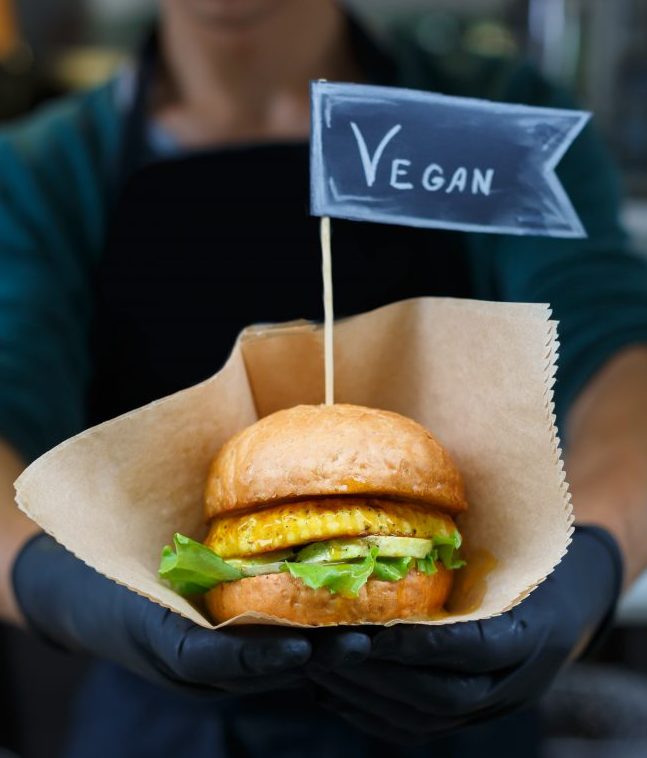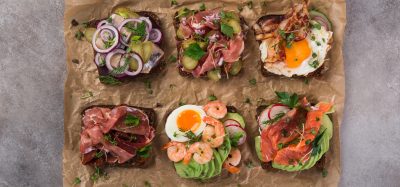Challenging issues for vegan and vegetarian food manufacturers
- Like
- Digg
- Del
- Tumblr
- VKontakte
- Buffer
- Love This
- Odnoklassniki
- Meneame
- Blogger
- Amazon
- Yahoo Mail
- Gmail
- AOL
- Newsvine
- HackerNews
- Evernote
- MySpace
- Mail.ru
- Viadeo
- Line
- Comments
- Yummly
- SMS
- Viber
- Telegram
- Subscribe
- Skype
- Facebook Messenger
- Kakao
- LiveJournal
- Yammer
- Edgar
- Fintel
- Mix
- Instapaper
- Copy Link
Posted: 10 April 2019 | Jessica Sage (Reading Scientific Services Ltd) | No comments yet
Skyrocketing demand for vegan and vegetarian foods has highlighted a number of manufacturing concerns – particularly with respect to on-pack claims. Here, Jessica Sage, food safety and quality consultant at Reading Scientific Services Ltd (RSSL), reviews the current state of play and key issues that are influencing developments.


Plant-based eating was one of the biggest food trends of 2018. Seen more as a lifestyle choice, there are a wealth of reasons why people are shunning animal food products, including the perceived health and wellness benefits, as well as ethical, welfare and environmental concerns. Whatever the motivation, the vegan dietary choice appeals to a wide consumer audience – an advantage that has undoubtedly helped to fuel its transition into the mainstream.
In fact, more people than ever are eating vegetarian or vegan products. Fifty-six percent of UK adults are now choosing to do so, while the number of US consumers identifying as vegan has increased 500 percent since 2014 to reach six percent of the population.
This marked shift in eating habits has created a buoyant category. Plant-based new product development (NPD) reportedly increased globally at 11 percent compound annual growth rate (CAGR) during 2013-17 and related on-pack claims increased 62 percent in the same period. In the UK, the share of new meat-free products carrying a ‘vegan’ or ‘no animal ingredients’ claim nearly doubled during 2014‑17. This upward trajectory shows no signs of slowing.


More people than ever are choosing vegetarian and vegan foods
Unsurprisingly, product developers have been quick to respond with a raft of innovative food and drink products, with vegetarian and vegan options appearing at a rapid rate across categories. These range from dairy alternatives, where the number of product launches has more than doubled over the last five years globally, to headline-grabbing meat substitutes aimed at a discerning flexitarian audience. Manufacturers continue to raise the bar in terms of taste, nutritional profile and eating enjoyment.
However, as the industry moves to capitalise on this significant opportunity, there is an underlying current of concern. It is becoming increasingly clear that vegan and vegetarian products require a carefully considered manufacturing strategy – after all, the stakes are high. Recent widespread media reports of both vegan and vegetarian products being contaminated with animal-derived ingredients show the impact of such incidents in terms of shaking consumer confidence and potentially damaging brand reputations.
Despite the current lack of legal framework defining what constitutes a vegan or vegetarian claim, producers must ensure that every available step is taken to substantiate these claims.
Clarity on claims
One of the main issues centres on the use of on-pack claims. With regard to vegan and vegetarian labelling, the European Commission has announced that it intends to begin the process of establishing a legal definition of both descriptors in 2019, as part of its ongoing Regulatory Fitness and Performance Programme (REFIT). This news has reportedly been warmly welcomed by both the European Vegetarian Union (EVU) – which has been lobbying the EU for such action since 2008 – as well as the industry association, Food Drink Europe (FDE).
In the meantime, many manufacturers are choosing to work with the Vegetarian Society and/or Vegan Society for permission to feature their approved trademarks on packs. The process of registration with these organisations is relatively straightforward and, importantly, is carried out per product rather than a blanket approval of the company in question. However, while visibility of such a logo undoubtedly sends a clear message in terms of the ethical aims of the organisation behind it, it is not a categoric guarantee of the complete absence of animal-derived ingredients. In fact, certified products are also permitted to carry a ‘may contain’ statement. This means that, for example, both the Vegan Society trademark and the statement ‘may contain traces of milk and egg’ could appear on the same pack. This is prompting high-level industry discussions and demand for guidance regarding the necessary controls for manufacture of vegan and vegetarian products.
In the UK, the share of new meat-free products carrying a ‘vegan’ or ‘no animal ingredients’ claim nearly doubled during 2014-17. This upward trajectory shows no signs of slowing
Some of the confusion stems from the disparity between the current legal position – where claims such as ‘vegan’ and ‘vegetarian’ are voluntary and covered by the Food Information for Consumers Regulation (EU FIC) – versus consumer perception that such labelling can be interpreted in the same way as allergen food safety advice. This is a potentially dangerous assumption, as tragically highlighted in recent media coverage. However, while there are currently no EU-approved best practice procedures in place, there are several practical strategies that manufacturers can adopt to ensure they are making every effort to substantiate these claims on products. Much can be learned from allergen management best practice; an area that provides valuable guiding principles in this context.
Key considerations for vegan labels
When considering whether a product should carry a vegan or vegetarian claim, a risk assessment should be conducted in order to identify the risks at each stage of the production process that could lead to the claim being invalid. The risk assessment should consider the entire process, from supply of raw materials through to despatch. Some examples of areas for consideration are as follows:
Supplier assurance
Ongoing communication between supplier and manufacturer is crucial. Implementing a supplier approval process is standard practice; allowing manufacturers to determine which materials are handled on site and any corresponding cross-contamination risks. But what happens if conditions at the supplier site change?
This is a fast-paced industry, which means that an approved supplier may suddenly start handling an animal-derived ingredient on site; potentially creating an issue for materials supplied for use in vegetarian and vegan products.
To avoid this situation, robust supplier quality assurance processes and regular audits must be in place – not only to minimise the risk of unintentional animal-derived products in materials, but also to ensure that any site developments are immediately flagged up.
Product scheduling
Where dedicated facilities are not available, manufacturers must address the issues of effective prioritisation, and whether the addition of vegan/ vegetarian lines requires a new way of thinking.
From a commercial perspective, it makes sense to decide what should be made and when based on customer demand; however, when it comes to preventing cross-contamination, other issues must be considered. In this context, the concept of ‘allergen build’ can be a useful reference.
In practical terms, the production run would start with products containing no animal-derived ingredients (vegan), followed by those containing milk or egg but no meat (vegetarian). This avoids introducing a potential cross-contamination risk or having to stop production for a cleaning intervention.
This approach is ideal, and if the manufacturer has no other considerations such as allergens, or claims such as ‘organic’ carried by some products, this is fairly straightforward. However, in the real world situations are not so clear-cut, and serious consideration must be given to the claims that take priority. Food safety considerations must always take priority over food quality, but this is complicated by the milk- or egg-allergic consumer assuming that a ‘vegan’ claim is equivalent to a ‘milk-free’ or ‘egg-free’ claim.
Physical segregation or dedication
In an ideal world, manufacturers would have a separate line for vegan products, another for milk-free, and so on – but clearly that’s not a commercially viable proposition.
Instead, all risks where unintentional presence of material could occur must be assessed. For each of these, the manufacturer must put controls in place that can be shown to manage these risks effectively. Some such other possible controls include dedicated production lines or parts of lines, or physically segregated lines. Consideration must be given to the risk of potential airborne contamination from such foods as powders or seasonings.
Other possible controls could be floor-to-ceiling curtains, or temporary physical barriers such as walls but evidence is needed to demonstrate their efficacy. It’s not enough to simply assume the chosen control method is working; validation is critical.
Cleaning as a control
On shared lines, cleaning is an essential control between products that contain animal-derived ingredients and those that don’t. The cleaning procedure needs to be validated to demonstrate that it is effective at removing the animal-derived material from the line and minimising the risk of carry over to the next product. However, this is not necessarily a straightforward task due to the analytical testing options that are currently available.
It might be the case that the cleaning validation process highlights a need for improvements to the cleaning procedure, wherein any possible improvements should be made before the validation process begins again. It could also be the case that the validation process demonstrates that, despite all possible steps being taken to attempt to improve the procedure, the cleaning cannot effectively remove the target to a consistently acceptable level and carry over into the next product cannot always be prevented. In this case, the use of claims around vegan or vegetarian status should should potentially be reconsidered.
Analytical testing
When looking for the presence of animal species within a product or ingredient, DNA detection using Polymerase Chain Reaction (PCR) is the most commonly adopted method. This method is generally very sensitive and can detect trace amounts of DNA within a sample. However, this method usually requires the user to have identified the species that is the likely source of contamination, as the test is targeted and will only look for specific DNA sequences. This presents a challenge for those who wish to look for potential contamination from unknown sources.
Food safety considerations must always take priority over food quality, but this is complicated by the milk- or egg-allergic consumer assuming that a ‘vegan’ claim is equivalent to a ‘milk-free’ or ‘egg‑free’ claim
To attempt to meet the industry need for a more generic screening method, RSSL is currently investigating a vertebrate screening test that, as the name suggests, will check for the presence of DNA from any animal with a backbone. This has potential to simplify the testing process for industry and make due diligence surveillance more straightforward. However, any generic screening test will have inherent limitations.
One significant limitation of this screening method is that human DNA is likely to be found; this is an unavoidable consequence of human involvement in the food production process. While validating this method, therefore, RSSL is looking to take steps to ensure that likely levels of this carry-over are assessed and the detection limit of the test adjusted accordingly. Being a screen, the test will also not specify the source of the DNA, so any positive results will require further analysis in order to fully identify them. Converting a DNA test result into a weight-for-weight contamination level is a real challenge because the units are not easily comparable.
Other considerations when utilising species-specific tests include the fact that a cow DNA test is unable to distinguish between DNA from milk and DNA from beef. Similarly, targeting chicken may lead to a positive result but it is not possible to know if this is due to the presence of chicken DNA or DNA from egg. All such considerations mean that lateral thinking when picking a target for testing is key, and a good laboratory with the right expertise should be able to guide manufacturers through this decision-making process.
An example might be when looking at cleaning validation, where using the target of concern for the clean might not actually be the best target in order to validate the clean. For instance, when validating the cleaning of a line that is used to produce beef lasagne, followed by a vegetarian product containing cheese, it would be natural to assume that the beef should be the target for the validation, as this is the carry-over concern. However, given the fact that quantifying levels of contamination from a DNA test is difficult, and that the milk in the lasagne sauce is likely to be harder to clean from the line, it could be advised that the most effective target for this validation would actually be milk, as there are quantitative sensitive ELISA tests available for it.
It can be an initially uncomfortable decision to make, but by always choosing the hardest-to-clean substance as the target and validating that it has been removed to an acceptable level, other materials of greater concern that are easier to clean are likely to have been cleaned away too.
Building knowledge
Of course, this is just the starting point in establishing robust manufacturing processes and bringing regulatory rigour to the vegan and vegetarian sectors. Ensuring everyone who works at the manufacturing site is properly trained is vital – as is communicating the reasons behind certain procedures and why they must be followed. Otherwise, corners can be cut and things can go wrong. The importance of effective training cannot be emphasised enough. Ongoing due diligence should also be part of the strategy. A series of regular checks will help to provide evidence that everything is as it should be, or potentially highlight that it’s not, in which case corrective action can be taken swiftly.
About the author
JESSICA SAGE is Food Safety and Quality Consultant at Reading Scientific Services Ltd (RSSL) a global leader at the forefront of scientific analysis, consultancy, product development and training, serving the food and consumer goods industries. For more information, visit www.rssl.com Twitter @RSSLtd Facebook @ Readingscientificservicesltd
References:
- http://www.mintel.com/ press-centre/food-and-drink/ more-than-half-of-all-meat-free-new-product-launches-in-the-uk-c arry-a-vegan-claim-1
- https://www.riseofthevegan.com/ blog/veganism-has-increased- 500-since-2014-in-the-us
- https://www.prnewswire.com/ news-releases/62-increase-in-plan t-based-product-claims-says-innov a-market-insights-300677563.html 4. http://www.mintel.com/ press-centre/food-and-drink/ more-than-half-of-all-meat-free-new-product-launches-in-the-uk-c arry-a-vegan-claim-1
Issue
Related topics
Allergens, Free From, Packaging & Labelling, Plant based, Quality analysis & quality control (QA/QC), Regulation & Legislation, The consumer
Related organisations
European Commission, European Vegetarian Union (EVU), Food Drink Europe (FDE), Vegan Society, Vegetarian Society









